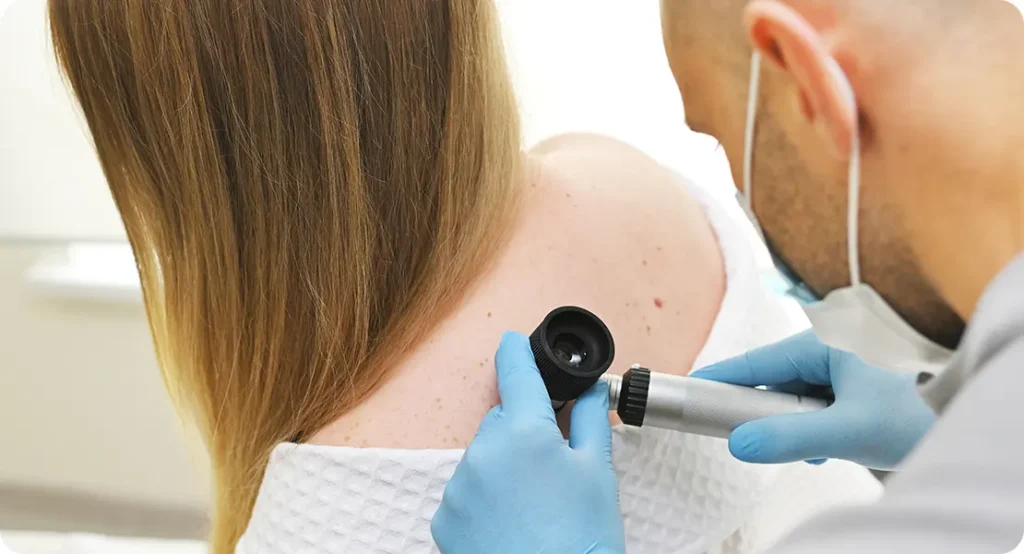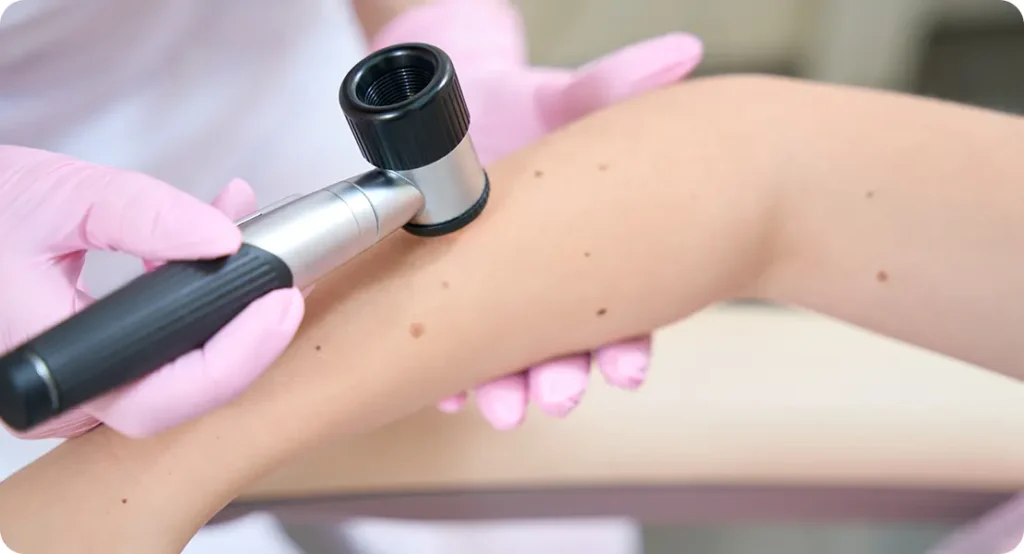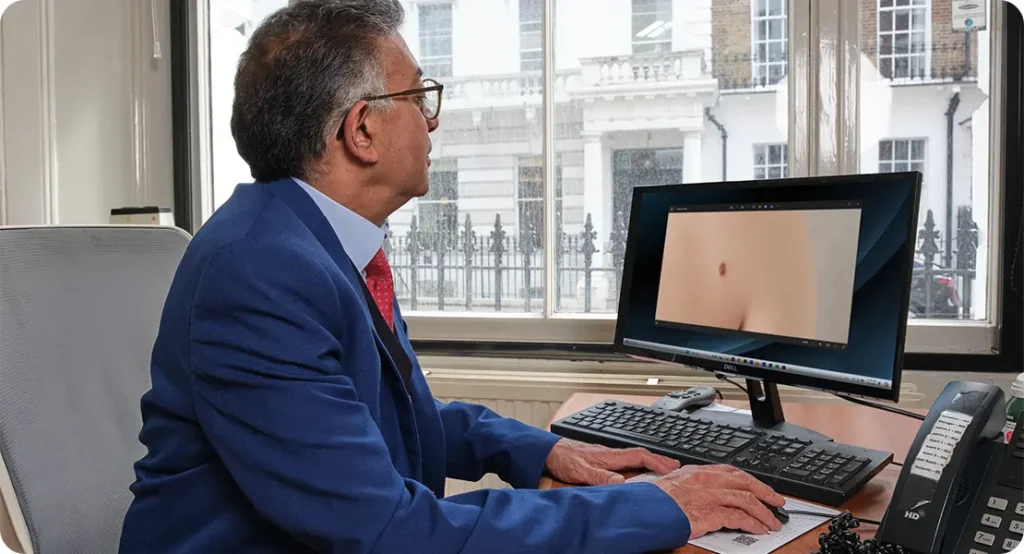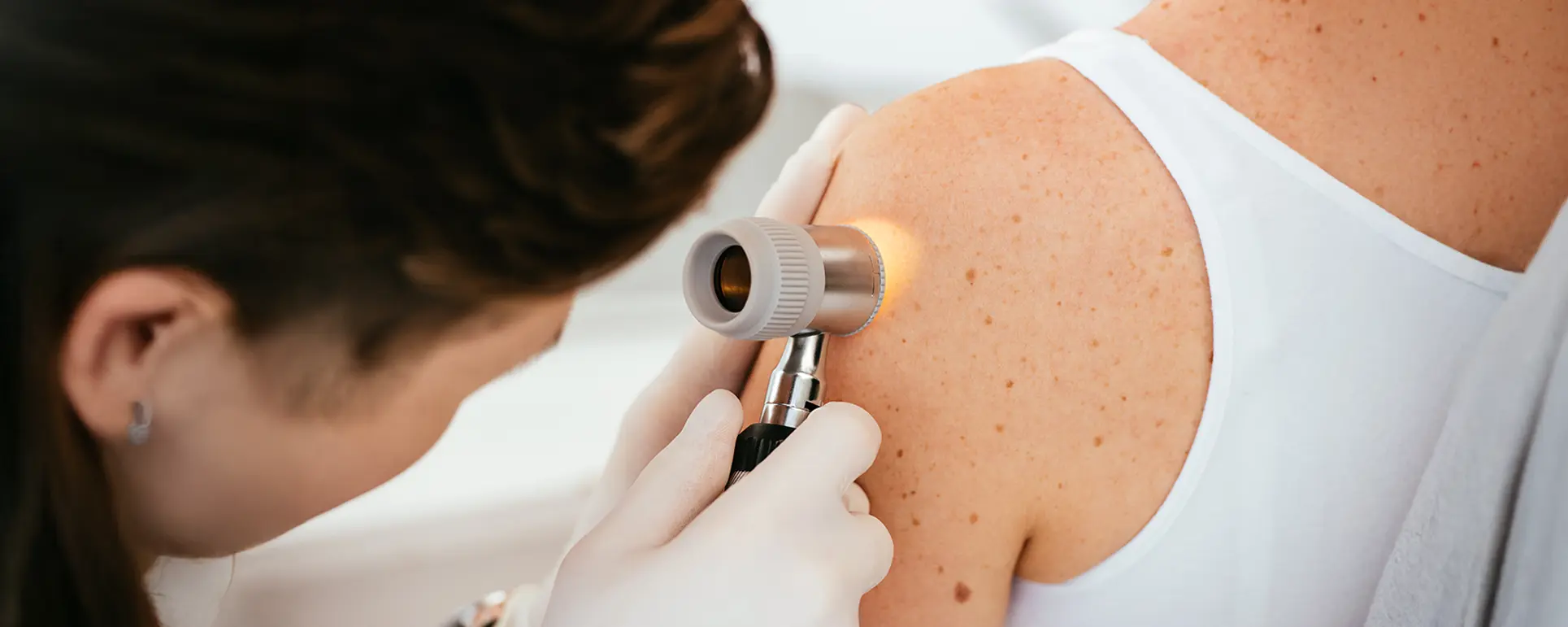We’ve all had the occasional spot or blemish that overstayed its welcome. A pimple that flared up and refused to leave, a patch of dry skin that kept coming back, or a red mark that never quite faded. Maybe you’ve tried creams, cleansers, home remedies, and every trick in the book, but this particular spot just won’t budge. It lingers, resists treatment, and keeps you guessing.
If you’re dealing with a persistent skin lesion that’s been hanging around for weeks or even months it’s completely understandable to feel concerned or even a bit frustrated. After all, our skin usually gives us clues when something is off, and anything that sticks around for too long is worth paying attention to.
While many lingering blemishes turn out to be harmless like a blocked pore, ingrown hair, or minor irritation some could be a sign of something more serious. Conditions like basal cell carcinoma, eczema, or even fungal infections can sometimes masquerade as acne or harmless spots. That’s why it’s so important to listen to your body and take action when something doesn’t feel right.
Today, I’m going to walk you through some of the possible causes of skin spots that don’t heal, what warning signs you should look out for, and when it’s time to see a dermatologist. Whether you’re dealing with a mystery bump, a scaly patch, or a sore that never seems to close, getting a professional diagnosis can offer clarity and peace of mind.
You deserve to feel confident in your skin and get the answers you need. Let’s take a closer look.
When Should You Be Concerned?
First, let’s set the scene.
Most of us are familiar with how regular spots behave. A typical pimple or acne lesion usually:
- Appears suddenly often during a hormonal flare-up or after a bout of stress
- Comes to a head within a few days to a week
- Dries out and fades within two weeks or so
- Leaves behind only a minor mark or none at all especially if you resist the urge to pick
In short, acne tends to follow a predictable pattern. It might be annoying or even painful, but it generally resolves on its own or with basic skincare.
But what happens when a blemish doesn’t follow the usual rules?
If you notice a spot that:
- Has been there for more than four weeks without improving
- Looks or feels different from your usual breakouts
- Feels unusually hard, raised, or rough to the touch
- Bleeds easily, crusts over, or forms a scab repeatedly
- Seems to be growing, darkening, or changing in shape over time
…it’s time to pay closer attention.
These signs don’t automatically mean something serious is going on, but they do suggest that your skin is trying to tell you something. Sometimes, what appears to be a lingering pimple could actually be a different type of skin condition or, in rare cases, a warning sign of something more concerning, like a precancerous lesion.
The bottom line? Not every stubborn blemish is cause for alarm, but if it’s outstaying its welcome and acting suspicious, it’s better to have it checked than to brush it off. Your skin’s health is too important to leave to guesswork.
Common Causes of Spots That Won’t Go Away

Not every lingering blemish is acne. In fact, several skin conditions can closely resemble breakouts but require very different treatment approaches. This is one of the main reasons why self-diagnosing through internet searches or treating a persistent spot like ordinary acne can sometimes do more harm than good. While it’s natural to assume a stubborn bump is “just a pimple,” your skin could be signalling something else entirely.
It’s also worth noting that some of these lookalike conditions don’t respond at all to typical acne treatments. You might find that no matter how consistent you are with your skincare routine cleansers, exfoliants, or spot creams nothing seems to work. That’s usually a sign that what you’re dealing with isn’t acne, but a different type of lesion altogether. And the longer it goes untreated, the more likely it is to worsen or cause irritation, inflammation, or scarring.
To help you understand what might really be going on, let’s explore some of the most common culprits behind spots that just won’t heal starting with cysts.
1. Cysts
What they are:
Cysts are sac-like pockets under the skin filled with fluid, keratin, or other material.
How they feel:
- Firm or rubbery lump beneath the surface
- Can become tender if inflamed
- Sometimes have a visible central pore
How they differ from acne:
Unlike a regular spot, a cyst often persists for months and doesn’t come to a head. Squeezing can make it worse or lead to infection.
Treatment:
A dermatologist can drain the cyst or remove it surgically if needed.
2. Basal Cell Carcinoma (BCC)
What it is:
BCC is the most common type of skin cancer. It often develops slowly in sun-exposed areas.
How it looks:
- A shiny, pearly bump
- May have visible blood vessels
- Can form a sore that bleeds and crusts but doesn’t heal
- Occasionally looks like a scar or patch of dry skin
How it differs from acne:
BCC doesn’t resolve on its own and may gradually enlarge over time.
Treatment:
Early detection is key. BCC is usually removed with minor surgery and rarely spreads elsewhere if treated promptly.
3. Squamous Cell Carcinoma (SCC)
What it is:
Another type of skin cancer, often caused by cumulative sun damage.
How it looks:
- A firm, red nodule
- A scaly patch or sore that doesn’t heal
- May feel crusty or tender
How it differs from acne:
SCC doesn’t respond to typical acne treatments and can become invasive if ignored.
Treatment:
Excision or other surgical methods are usually recommended.
4. Dermatofibroma
What it is:
A benign growth of fibrous tissue, usually caused by minor trauma like an insect bite or injury.
How it feels:
- A small, firm nodule
- Usually painless
- When you pinch it, the centre may dimple inward
How it differs from acne:
It won’t come to a head, and it doesn’t go away without removal.
Treatment:
Dermatofibromas are harmless, but you can have them removed for cosmetic reasons or if they’re irritated by clothing.
5. Sebaceous Hyperplasia
What it is:
Overgrowth of oil glands, common in middle-aged adults.
How it looks:
- Small, yellowish bumps
- Central depression (umbilication)
- Often found on the forehead and cheeks
How it differs from acne:
Sebaceous hyperplasia doesn’t get inflamed like a pimple and doesn’t respond to acne creams.
Treatment:
Dermatologists can use laser treatment, cautery, or minor surgery to remove them.
6. Keratoacanthoma
What it is:
A rapidly growing lesion that looks alarming but is usually benign.
How it looks:
- A dome-shaped nodule
- Central keratin plug
- Can grow quickly over weeks
How it differs from acne:
The speed of growth and size are usually what stand out.
Treatment:
Because it resembles skin cancer, it’s usually removed surgically.
Why Early Diagnosis Matters

You might be wondering if it’s really necessary to see a professional for something as small as a lingering spot. After all, it’s just one patch of skin how serious could it be? But when it comes to your skin health, early diagnosis can make a world of difference.
Here’s why it matters more than you might think:
- Peace of mind
Let’s face it when you’ve had a stubborn blemish for weeks or months, your mind can go to some worrying places. Is it just a blocked pore? Could it be something more serious? Rather than continuing to stress or search online for conflicting answers, a quick consultation with a dermatologist can give you the clarity you need. Knowing exactly what you’re dealing with can ease anxiety and help you take the right steps forward. - More effective treatment
Not all skin conditions respond to over-the-counter creams or home remedies. In fact, some conditions like actinic keratosis, fungal infections, or certain types of eczema can actually worsen if treated incorrectly. A dermatologist can provide an accurate diagnosis and prescribe targeted treatments that actually work. This can save you time, money, and frustration in the long run. - Better long-term outcomes
In some cases, a spot that won’t go away could be an early form of skin cancer, such as basal cell carcinoma or squamous cell carcinoma. The good news? When caught early, these conditions are highly treatable often with minimally invasive procedures that leave little or no scarring. But the longer they go undetected, the more complex treatment can become. Early diagnosis gives you the best chance at a full, uncomplicated recovery.
It’s also worth remembering: you don’t need to feel embarrassed or worry that you’re “overreacting.” Dermatologists deal with all types of skin lesions every day. Whether it turns out to be something serious or just a harmless blemish, they’re there to help not to judge. Your concerns are valid, and getting answers is a smart, proactive move.
What to Expect at a Dermatology Appointment

If you’ve decided to get your persistent spot checked out, you’ve already taken a positive step towards understanding your skin better. But if it’s your first time seeing a dermatologist or it’s been a while you might be unsure about what the appointment will involve. Knowing what to expect can make the process feel much less intimidating.
Here’s a breakdown of what typically happens during a dermatology consultation:
- Medical History & Symptom Overview
The dermatologist will start by asking a few questions about the lesion. How long has it been there? Has it changed in size, colour, or texture? Does it itch, bleed, or hurt? They’ll also ask about any skincare products or treatments you’ve already tried, and whether you’ve had similar issues before. This information helps them understand the context and narrow down possible causes. - Skin Examination
Next, the dermatologist will examine the spot closely. This may include a general visual inspection of the area and surrounding skin. To get a more detailed view, they might use a handheld tool called a dermatoscope a special magnifying device with a light that allows them to see deeper structures beneath the surface of the skin. It’s completely painless and helps them identify features that aren’t visible to the naked eye. - Diagnosis
In many cases, an experienced dermatologist can make a diagnosis based purely on visual examination and your symptom history. However, if the lesion is unusual or unclear, they may recommend a biopsy. This involves removing a small sample of the affected skin under local anaesthetic so it can be examined under a microscope. Biopsies are typically quick and minimally invasive, with little to no downtime. - Treatment Options
Once a diagnosis is made, your dermatologist will explain the next steps. This could include:
- Topical treatments, such as prescription creams or ointments
- Oral medication, if the condition is part of a broader issue like an infection or inflammatory disease
- Minor procedures, such as freezing (cryotherapy), curettage, or excision to remove the lesion entirely
- Monitoring, especially if the lesion isn’t immediately concerning but needs to be watched over time for any changes
Your dermatologist will take the time to answer your questions, address any concerns, and make sure you understand the diagnosis and treatment plan. The goal is always to support your skin health and help you feel confident in the care you’re receiving.
How to Monitor Your Spot at Home
If you’ve noticed a blemish that just won’t go away and you’re waiting for a dermatology appointment or still deciding whether to book one it’s a good idea to start monitoring the area yourself. Keeping track of any changes can provide useful information for your dermatologist and give you a better sense of whether the spot is stable or evolving over time.
Here are a few simple but effective ways to keep an eye on your skin at home:
- Take clear, consistent photos each week
Use your smartphone to take close-up pictures of the lesion once a week. Try to use the same lighting, distance, and angle each time. Natural daylight is best, and taking the photo in front of a neutral background can help with clarity. Consider including a coin or ruler in the frame to show scale. These photos can be really helpful when you’re discussing your concerns with a dermatologist they allow professionals to see any subtle changes that may not be obvious day to day. - Keep a written log of any changes
In addition to photos, jot down any symptoms you observe. Has the spot changed in size? Is the colour darker, redder, or uneven? Has the texture become rough, scaly, or raised? Is it painful to touch, itchy, or starting to bleed? Even small changes can be significant over time, and documenting them ensures you won’t forget important details during your appointment. - Avoid picking, scratching, or squeezing
As tempting as it may be, resist the urge to interfere with the lesion. Picking or squeezing can distort the appearance of the spot, introduce bacteria, and lead to infections or scarring. It also makes it harder for a dermatologist to assess the area accurately. Keeping your hands off the spot helps preserve its natural appearance and avoids adding new complications. - Watch for red flags
While many persistent blemishes are harmless, certain signs should prompt faster action. If you notice:
- Rapid growth in size
- Frequent or unexplained bleeding
- The spot suddenly becoming darker, redder, or changing colour
- A lesion that doesn’t heal or keeps scabbing over
- Pain that gets worse over time
…don’t wait for your next scheduled check-up. Reach out to a healthcare provider as soon as possible. These changes could indicate something more serious that needs urgent evaluation.
Monitoring your skin carefully at home is a smart, proactive step. It not only gives you peace of mind but also equips your dermatologist with valuable insight that can support a faster, more accurate diagnosis.
Final Thought: Don’t Ignore That Lingering Spot Get Answers Today
If you’ve got a spot that refuses to heal, you don’t have to keep worrying or guessing what it might be. Many persistent skin lesions are harmless, but some need prompt treatment. The most important thing is not to ignore a blemish that looks or feels different. You deserve clarity, confidence, and the right care. If you’re ready to get clarity and peace of mind, book a consultation with one of our expert dermatologists. We’re here to support you with trusted care and help you feel confident in your skin.
References:
- Kumar, P. and Marks, R., 1987. Sebaceous gland hyperplasia and senile comedones: a prevalence study in elderly hospitalized patients. British Journal of Dermatology. Available at: https://en.wikipedia.org/wiki/Sebaceous_hyperplasia
- Ahmadi, M. et al., 2023. Challenging Patterns of Atypical Dermatofibromas and Promising … narrative review, summarizing clinical and dermoscopic features to differentiate from malignant lesions. Available at: https://pmc.ncbi.nlm.nih.gov/articles/PMC9955442/
- Ratner, D., 2012. Keratoacanthoma. In: Fitzpatrick’s Dermatology in General Medicine. 8th ed. New York: McGraw‑Hill. Available at: https://en.wikipedia.org/wiki/Keratoacanthoma
- Cerroni, L., 2013. Line‑field confocal optical coherence tomography increases diagnostic accuracy in basal cell carcinoma. Cancer, 14(4), pp. 98–108. https://doi.org/10.3390/cancers14041082
- Dellmann, H.D. and Plewig, G., 2003. Sebaceous Hyperplasia: clinical features and differential diagnosis. American Family Physician, 15 February 2003. Available at: https://www.aafp.org/pubs/afp/issues/2003/0215/p729.html
